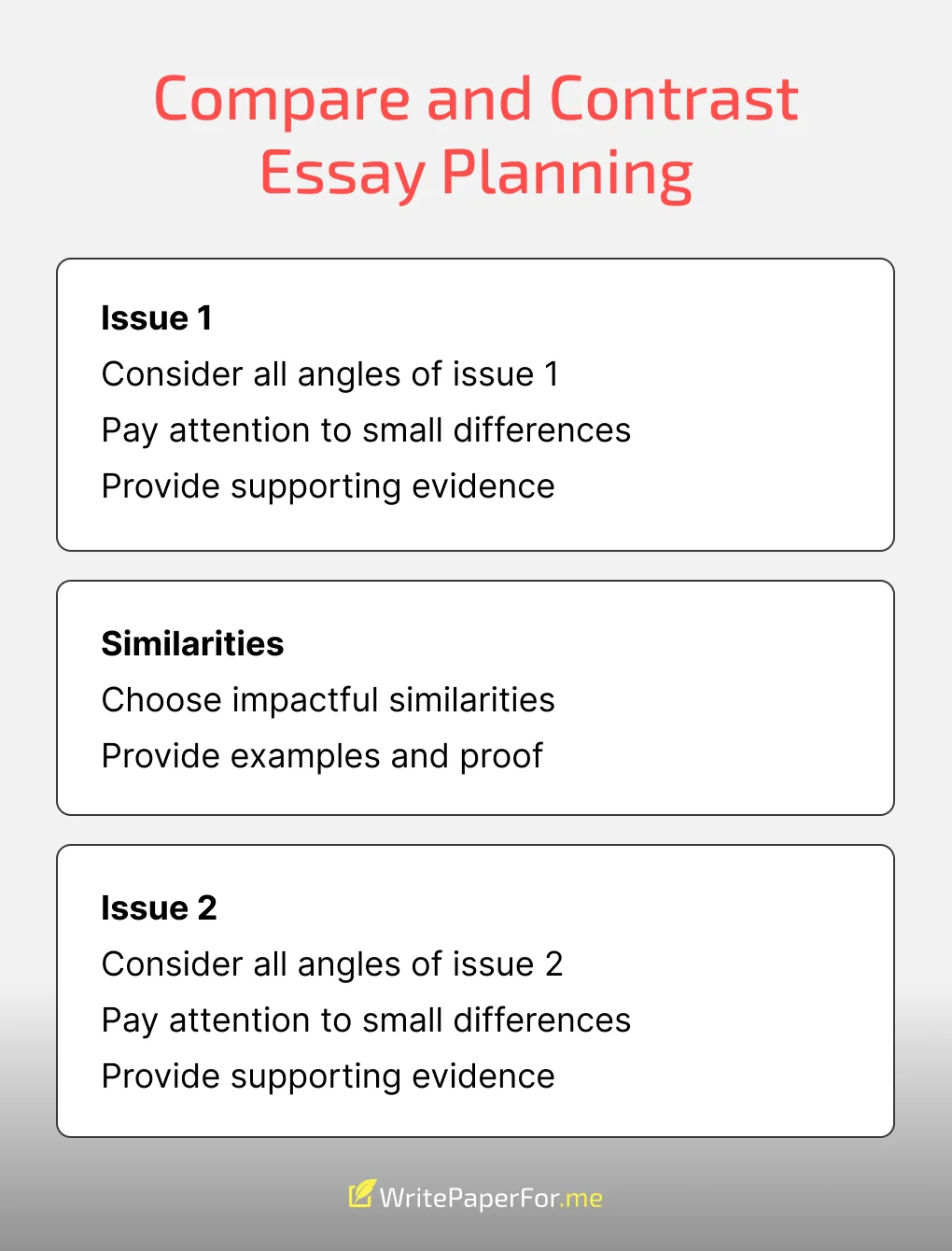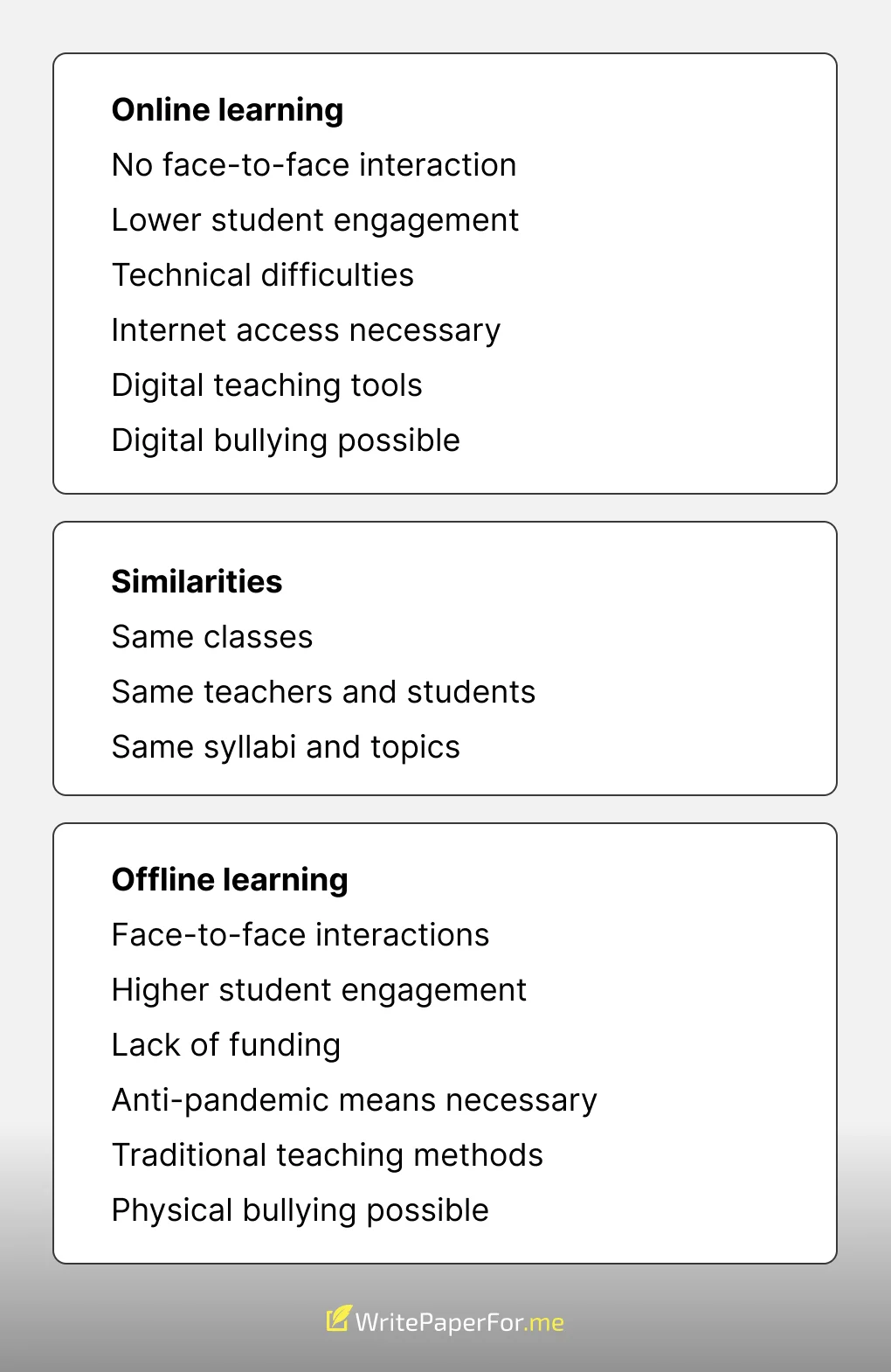If you have ever used a compare feature when shopping on Amazon, you have a rough idea of what a compare-and-contrast essay entails. It's a cornerstone of academic writing assignments that is more tricky than it seems at first glance. We have prepared this detailed writing guide to help you avoid the common pitfalls and score the top marks on your next project.
What Is a Compare and Contrast Essay?
A compare-and-contrast essay is a common type of college and university assignment. Its main goal, as the name suggests, is to compare and contrast two or more subjects. The student has to highlight the differences and the common traits. This assignment is typical across multiple subjects and classes. Whether you're a major in Social Sciences, Gender Studies, or Business, you will likely have to write a few comparison essays.
The Purpose of a Compare-and-Contrast Essay
Like most writing assignments, a comparison/contrast piece develops hard and soft skills. While researching the issues related to your class or major enhances professional expertise, the comparison and contrast part of the task promotes multiple soft skills necessary across various fields and professions, such as
- Attention to detail. Before you sit down to write, you'll need to examine the subjects from all angles to learn the subtle similarities and differences that aren't obvious.
- Critical thinking. You need to evaluate all criteria for comparison/contrast to choose the most compelling ones for your writing, demonstrating your critical thinking skills.
- Analysis and synthesis. First, you will deconstruct each subject to find the traits to compare and contrast and use reference data and personal experience to synthesize a compelling narrative to tie all comparison criteria together.
How to Structure a Compare-and-Contrast Essay
Like most academic assignments, compare and contrast essays follow the traditional three-part structure. The introduction and conclusion are mandatory. But it's the body paragraphs that usually give students trouble. There are two common ways to structure the main part of the essay. Let's take a closer look at both of them.
Point-by-Point Method
In a point-by-point approach, you dedicate each body paragraph to one of the criteria for comparison/contrast and describe how the subjects are similar or different based on this particular characteristic. This structure is more challenging to develop and use during writing, as it requires a deeper understanding of the topic and excellent synthesis skills to combine disparate topics in a single passage.
Although the point-by-point compare and contrast structure is more challenging to master, it's also easier to follow for readers. Besides, with this approach, you can rely on persuasive writing tricks by ordering the comparison/contrast criteria to have the necessary effect on your audience.
A basic compare and contrast essay outline using this approach would look like this:
- Introduction
- Body paragraph 1 - compare and contrast aspect 1
- Argument and supporting evidence for topic 1
- Argument and supporting evidence for topic 2
- Body paragraph 2 - comparison and contrast of aspect 2
- Argument and supporting evidence for topic 1
- Argument and supporting evidence for topic 2
- Body paragraph 3 - compare and contrast aspect 3
- Argument and supporting evidence for topic 1
- Argument and supporting evidence for topic 2
- Conclusion

Block Method
The easier of the two, the block compare and contrast outline comprises two (or more) blocks devoted to one subject of the comparison. So you first cover all aspects of one issue, highlighting its common and disparate traits, then go over the other.
The block approach to compare-and-contrast essays provides faster results, but avoiding unnecessary repetition when describing similarities can be tricky. Besides, the contrast may get lost without clear transitions and connections when differences are spread too far apart.
The rough outline of a block comparison/contrast paper would look like this:
- Introduction
- Body paragraph 1
- Aspect 1
- Aspect 2
- Aspect 3
- Supporting evidence
- Body paragraph 2
- Aspect 1
- Aspect 2
- Aspect 3
- Supporting evidence
- Body paragraph 3
- The value of comparison/contrast
- Conclusion
Where to Find Good Compare-and-contrast Essay Ideas
If you have free rein over the subject of your compare-and-contrast essay, developing an exciting idea can be challenging. We suggest four brainstorming options that are guaranteed to produce a usable topic:
- Your academic interests and passion. The key to creating a compelling comparison/contrast paper is making the reader as interested and excited about the subject as you are.
- Social media and news feed. Check out the headlines if you are looking for the most relevant ideas for your contrast essay. Look for trends related to your class and syllabus.
- Suggested reading. Skim the list your professor provides to look for ideas. Unlike other methods, this one will always offer topics related to your class, though they may not be the most exciting ones.
- Past assignments. Remember your favorite topics from previous classes if you're short on time. You've already done your research and have the basic understanding to quickly craft a compelling compare-and-contrast essay.
With a basic understanding of how to write a compare and contrast essay, let's now look at a few sample paragraphs that put theory into practice.
Compare-and-Contrast Essay Example: Thesis and Paragraphs
The full-length example compare and contrast essay would be too much for this short guide, so we'll instead provide a sample introduction and body paragraph to help you wrap your head around everything we've covered.
Sample topic:
The Similarities and Differences Between Online and Offline College Education Throughout the Covid-19 Pandemic
The first paragraph should introduce two subjects and include a thesis statement:
The Covid-19 pandemic challenged the educational system to adopt online and blended teaching methods to replace traditional offline classrooms to mitigate the spread of the virus. Although disciplines, professors, and syllabi are the same across offline and online learning, the lack of face-to-face communication, technical challenges, and the need for new teaching tools set online education apart from traditional classes.
The third body paragraph in this example would be devoted to teaching tools:
Traditional classrooms haven't changed much over the last century, even if they replaced blackboards with screens and projectors and students' notebooks with laptops. However, the first weeks of online classes demonstrated the inefficiency of lectures, presentations, and quizzes for remote and blended learning environments. As the quality of education dropped, professors were forced to adapt and adopt new digital learning tools, such as digital class-wide whiteboards, surveys and polls, and interactive quizzes. While some of these features could be useful in a traditional classroom, most are only possible and practical for online classes.
Tips for Writing Compare-and-Contrast Essays
We could teach a month-long class on writing compare and contrast essays, but we won't squeeze all that minutiae into this short writing guide. Instead, we will share a handful of the most effective ways to improve your writing with minimum effort. All you need to do is follow four simple steps:
- Use transition phrases where appropriate. In compare and contrast essay writing, it can be easy to lose track of your flow of ideas. To help the reader stay on the same page, use transitional phrases such as "on the other hand", "alternatively", "unlike", etc.
- Avoid confusion and misunderstandings. Even if you're writing for your major-related class, keep jargon and specialized terms to a minimum. But if you must resort to using them, provide definitions and explanations. Do not assume your readers have the necessary knowledge to understand your arguments and supporting evidence.
- Leave enough time for editing and proofreading. The post-writing stages of your assignment can take as much time as the writing itself. Ideally, you want to give yourself at least a day to get away from your project and look it over with fresh eyes. First, reread the paper as your worst critic and look for any inconsistencies, illogical transitions, or weak arguments. Eliminate them. After that, use professional writing software such as Grammarly to catch any lingering mistakes and typos.
- Get a second opinion. If you are working on a critical assignment that counts for a considerable portion of your term grade, it's helpful to get a second opinion, ideally from a writing professional. But you can also settle for exchanging essays with your classmate to look them over and point out weaknesses.

10 Excellent Compare and Contrast Essay Topics
In most cases, your professor will provide a topic for your contrast piece. But if your instructor decides to be difficult and give you free choice of a research question, the endless options may be a challenge. To find inspiration, check out our short list of 10 excellent topics across various subjects.
- The subtle differences and similarities between Harry Potter books and movies only fans know about
- Analyzing the political campaigns of Donald Trump and Joseph Biden throughout the presidential election of 2020
- Contrast the healthcare systems in the US and Canada
- Comparison of Agile and Kanban project management methodologies in software development
- Highlighting the differences between vegetarianism and veganism
- Comparing the monetary and non-monetary benefits for male and female managers
- Analyzing the contents, nutritional value, and cost of organic and non-organic groceries
- Comparing the benefits and drawbacks of Android and iOS mobile operating systems
- Analyzing the production and usage effects of internal combustion engine vehicles with electric cars
- Comparison of the impact of Facebook, Instagram, and TikTok on the self-worth of different generations of teenagers
These are just a few of the relevant ideas we came up with on short notice. Still, you're free to use any verbatim, alter them, or twist them around until they are unrecognizable and unique.
Final Thoughts
Writing a compare-and-contrast essay is more of a challenge than it seems at first glance. It requires in-depth research into both subjects of your comparison. Besides, it tests your analysis and critical thinking skills and narrative writing.
If you have a critical compare and contrast paper due in a few short days and don't know where to start your research, professional writing help may be your salvation. Reach out to our support team to learn more about how our professional academic writers can help you turn in this assignment on time and receive good marks.
We employ hundreds of experts across all majors to match you with the best person to complete your task. Our professionals can deliver your paper in as little as 6 hours. So the sooner you place your order, the sooner you download the finished piece. Or, if you are feeling overwhelmed by your academic workload, you can always ask someone to take my online class for me and get some relief from your stress.





